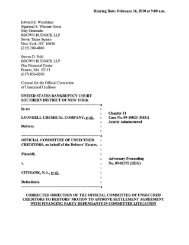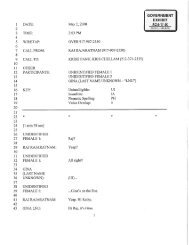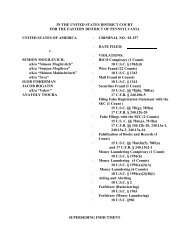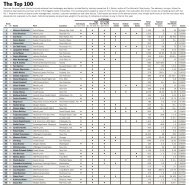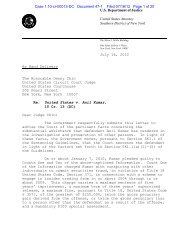Salz Review - Wall Street Journal
Salz Review - Wall Street Journal
Salz Review - Wall Street Journal
You also want an ePaper? Increase the reach of your titles
YUMPU automatically turns print PDFs into web optimized ePapers that Google loves.
189<br />
<strong>Salz</strong> <strong>Review</strong><br />
An Independent <strong>Review</strong> of Barclays’ Business Practices<br />
The Leader’s Role<br />
Psychoanalyst Manfred Kets de Vrie 283 identified that the key skills of leaders in shaping<br />
culture and delivering change are self-awareness and the ability to change personally at all<br />
levels, intellectually, emotionally and behaviourally. When leaders engage in personal<br />
learning and change, they signal to the organisation that transformation is safe and<br />
important to the future survival and success of the organisation. Actions speak louder than<br />
words. Humility and the ability to consciously reflect are required for leaders to succeed in<br />
leading transformational change. These are characteristics associated with helping oneself<br />
and others to grow. 284<br />
Growing and learning often involves failure and can be embarrassing. So leaders who can<br />
overcome their fears and broadcast their feelings as they work through the messy internal<br />
growth process will be viewed more favourably by their employees. Researchers, Owen and<br />
Heckman, found that those leaders who model how to be human rather than superhuman<br />
and legitimise ‘becoming’ rather than ‘pretending’, were considered more effective. You<br />
cannot fake humility. You either genuinely want to grow and develop, or you do not, and<br />
people pick up on this. Leaders who action their own change and growth signal to<br />
followers that learning, growth, mistakes, uncertainty and false starts are normal and<br />
expected in the workplace, and this produces organisations that constantly keep growing<br />
and improving.<br />
Strategy and culture can be said to work hand in hand – two sides of the same coin – with<br />
strategy signified by the purpose (why we do what we do), mission, vision and objectives of<br />
the organisation (the what we do), and culture – signified by the values, behaviours and<br />
working practices (the how we do it). It is the leader’s role to focus on both the strategic<br />
and cultural development of the organisation, weaving a system which enables the<br />
organisation to survive, grow and adapt to meet the needs of the environment in which it<br />
works. This work can only be done by leaders who are prepared to engage at a personal as<br />
well as systemic level. Changing the ‘how we do things’ is for most leaders where the<br />
risks lie.<br />
The Role of Employees<br />
Working with and for others is deeply engrained in our biological evolution. Through<br />
infancy, childhood and adulthood, we retain a propensity to work in groups and accept<br />
particular individuals to co-ordinate our efforts and take on leadership roles. However,<br />
what makes a good employee has generally been understudied and is typically understated<br />
in organisational life. Leadership, on the other hand, has been much studied and often over<br />
romanticised: Google gets about 120,000 hits when you type in ‘followership’ (or<br />
‘citizenship’), versus more like one million for ‘leadership’. In fact we struggle, in an<br />
organisational sense, to even effectively label individuals who are not in leadership or<br />
managerial roles, calling them variously employees, colleagues, workers, team members,<br />
staff or even – most recently – citizens.<br />
283 Manfred Kets de Vries, The Leader on the Couch, 2006.<br />
284 Bradley Owens and David Heckman, Modelling How to Grow: An Inductive Examination of Humble Leader<br />
Behaviours, Contingencies, and Outcomes, 2012.







